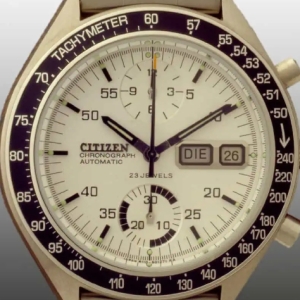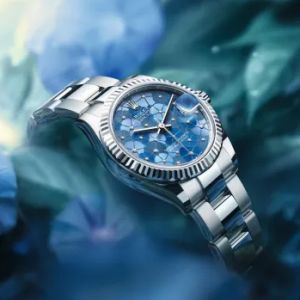Citizen Challenge-Timer Automatic Chronograph 8110A: The story of the Citizen SpeedyPosted by lifata on December 29th, 2023  Flashback 1969In 1972, the era of automatic chronographs began at Citizen with the Citizen Challenge-Timer Automatic Chronograph. At this point, this type of watch already had a three-year history. In the second half of the 1960s, Breitling and Heuer, together with the mechanical specialists Büren and Dubois-Dépraz, competed with the watch replicas uk manufacturer Zenith in Switzerland. And Seiko was working on its own creation in the land of the rising sun. The premiere of wristwatches with differently constructed automatic movements took place in 1969, with the Japanese leading the way when series production began. In 1971, the calibers 1340 and 1341 from the specialist Lémania, based in the Vallée de Joux, followed. Mother Omega brought these movements onto the market under the names 1040 and 1041. Common features are the horizontal wheel clutch and gate switching of the two-push button chronograph with a central minute counter and 12-hour totalizer at “6”. The central rotor tensions the tension spring in both directions of rotation. The autonomy of the time mechanism, which oscillates at four Hertz, is approximately 44 hours. Citizen Challenge timerBehind it was Citizen Watch Co. Ltd., founded in Tokyo in 1930. Of course, don't stand back. In the 1960s, she focused on electronic clockworks, without completely losing sight of the traditional mechanics. The caliber 6139B, introduced by Seiko in 1969, probably inspired Citizen to take action of its own. Two years later, prototypes of the caliber 8100A without an hour counter and 8110A with an hour counter were ticking. Both did this at four hertz. Series production of these automatic movements began in 1972. According to current knowledge, it lasted until 1980. The Citizen Challenge-Timer Chronograph pictured with the reference number 67-9313 contains the caliber 8110A. Because of the tachymeter scale on the glass edge of the steel case, which measures just 39 millimeters, this Japanese stopper was nicknamed Citizen Speedy. A look at the dial shows a 30-minute counter at “6”. Opposite, the 12-hour totalizer makes its rounds. However, there is no permanent second to check the function of the movement. In the opinion of the technicians, this was also dispensable. When it came to the clutch, the Citizen team used competitor Seiko's caliber 6139B and relied on friction. This system requires less energy. Therefore, the central stop hand can always run without massively affecting the balance amplitude. Once the double-sided ball bearing rotor with an outer heavy metal segment has fully tensioned the mainspring, around 40 hours of running time are available. The rate is regulated by a regulator system which influences the active length of the flat balance spring. An eccentric screw on the balance cock makes fine adjustment easier. Automatic and flybackThe 27 millimeter large and 6.72 millimeter high oeuvre is equipped with 23 functional stones. Similar to the Seiko 6139B, in addition to the window date, it also has a digital, bilingual weekday display, like Seiko's. Of course there is a quick adjustment for both indications. The crown, once pulled out, affects the date. The day of the week can be adjusted by pressing the zero setting button. The special feature of the stop mechanism, which is controlled by a classic ratchet wheel, is a flyback function. This means that the chronograph can be stopped while running, reset to zero and immediately restarted by pressing the pusher located at “4”. At the time, Citizen referred to the practical speed control as Instant Start. A so-called buffer system is also involved. Citizen integrated it because, according to the engineers there, a sudden strong impact on the zero-setting pusher could lead to a malfunction of the chronograph. The buffer mechanism prevents such problems. Citizen SpeedyThe Citizen Flyback Speedy Chronograph reference 67-9313 was available with a white or black dial at the time. By the way, the division of the seconds scale is incorrect. If you look closely, you will discover four small fractional indices. However, these correspond to a traditional balance frequency of 2.5 Hertz, which enables fifth-second stops. During the brisk 28,800 half-oscillations that the Citizen 8110A caliber's gear regulator completes every hour, the chronograph operates with an accuracy of an eighth of a second. The correct number would therefore be seven (unreadable) or just three small lines. Seiko didn't think about this fact at the time either. And even the design guru Ferdinand A. Porsche (you can read an interesting interview from the past here on Uhrenkosmos) gave the chronograph he designed four division lines, despite the modern four Hertz balance frequency, according to the old custom. People simply weren't aware of this frequency issue back then. And even among important watch manufacturers, the tradition lives on, regardless of the higher oscillation speed. This replica watch uk is definitely worth it, especially since, as far as I know, the 8110 Challenge Timer is the world's first automatic chronograph with a permanent zero setting or flyback function. Like it? Share it!More by this author |


